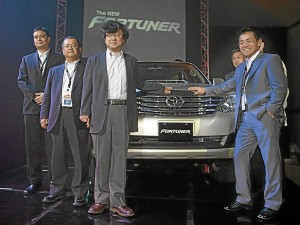When supply cannot meet demand

TOYOTA Motor Philippines president Michinobu Sugata (fourth from left) and Kaoru Hosokawa (third from left), chief engineer of TMP, lead the unveiling of the facelifted Fortuner at the NBC Tent recently. Joining them are, from left, Raymond Rodriguez, first vice president for Marketing; Yuji Goto, executive vice president; Santos Guerrero, senior vice president for Marketing.
At the Toyota Tent Event media preview last Wednesday, Toyota Motor Philippines Corp. (TMP) president Michinobu Sugata told business reporters that among the Japanese car manufacturers whose supply chain was disrupted by the March 11 earthquake and tsunami, Toyota has recovered the fastest. Sugata forecast TMP sales to slightly increase this year to 57,000 units from last year’s 56,855 with the full resumption of two-shift operations at their Sta. Rosa plant and the improved availability of completely built units (CBUs).
In the Philippines, Toyota was never in danger of losing its market leadership although its sales declined in May and June after TMP had to cut production by half to stretch its available parts inventory. Honda Cars Philippines Inc. (HCPI) was more severely affected by the twin disasters in Fukushima and issued press releases apologizing to customers for the delay in the delivery of their purchase orders.
Shortfall
The parts inventory shortfall caused Honda Motor Co. to reset the launch of the redesigned 2012 Civic in the United States, its most important market. Likewise, the new 2012 CR-V will be launched in the US a month later than originally planned. Although almost 90 percent of the Honda vehicles sold in America are made in the region, some electronic components are produced at factories in Japan that were damaged in the earthquake. Given these delays, the 2012 Civic and CR-V will probably arrive in Manila next year much later than originally expected.
This should be good news for Hyundai Asia Resources Inc. (HARI), which overtook HCPI in March 2010 as the country’s third top-ranking automotive brand after Toyota and Mitsubishi. Hyundai Motor has no supply problems since it gets only one percent of its parts from Japan. HARI’s annual growth averaged 48 percent in the last 10 years, peaking at 82 percent last year and earning for HARI the Global Distributor of the Year Award, Hyundai Motor Company’s highest distinction.
Article continues after this advertisementPlunge
Article continues after this advertisementHowever, last month HARI’s sales plunged 25 percent as the number of cars allocated to the Philippine market was cut down. In an informal interview, HARI CEO and president Ma. Fe Perez-Agudo said that when Hyundai Motor Co. exports, for example, 250 units of various models for distribution in Southeast Asia, those 250 units are divided among Thailand, Singapore, Malaysia, Indonesia, the Philippines, etc. Thus, the months-long waiting period for Hyundai customers and the decline in sales.
In other words, Hyundai Motor seems to be a victim of its own success. Its factories (three in Korea, six overseas) are working overtime to meet the global demand for its products. Wall Street Journal motoring columnist Dan Neil wrote recently that the new Elantra outsold each of Japan’s compacts—Toyota Corolla, Honda Civic and Nissan Sentra—in the US last June (maybe the Japanese cars were in short supply?)
40 MPG
Noting that the fuel economy of four Hyundai models (Sonata hybrid, Elantra, Accent and the soon-to-be-launched Velostar compact coupé) average 40 mpg (16.8 km per liter), Neil continued: “Add up all the 40-mpg Focuses and Fiestas Ford sold between January and June, throw in all the 40-mpg Chevy Cruzes and all the Smart Cars sold, and the total is still less than a third of the number of Elantras sold. Just Elantras. Somebody call a cop.”
Naturally, Hyundai mostly manufactures in or delivers to big markets like the US, Europe (where diesel-fed cars are best-sellers) and the Bric economies (Brazil, Russia, India, China) where car sales grow rapidly every year. But increasingly, automakers are focusing on Asia as the global financial balance is shifting to this part of the world.
Wealth
Asia is where the money is now, as shown by the latest annual wealth report from Capgemini/Merrill Lynch stating that the number of high net-worth Asians—those having more than $1 million in disposable income—soared to 3.3 million in 2010 while their wealth climbed to $10.3 trillion. In comparison, Europe had 3.1 million millionaires last year while North America had 3.4 million.
According to Reuters, Singapore has the highest concentration of millionaire households in the world with 15.5 percent having more than $1 million in assets under management. In Singapore, just one BMW dealership sells around 350 cars a month while in mainland China, Hong Kong, Macau and Taiwan, BMW claims to have already sold a total of 130,659 cars in the first six months of the year, or up 60 percent from a year earlier. While over here, it takes a year—12 months—to sell around 175,000 new vehicles ranging from subcompacts to luxury cars.
What does all this have to do with the subject of supply and demand? It just goes to show that as inventory issues recede, auto manufacturers—whether mass market like Hyundai in the US or luxury like BMW in Singapore—prefer to cater to consumer demand in established and steadily/rapidly growing markets. The small, nearly stagnant Philippine car market will remain low priority.
TODAY’S BUMPER STICKER DEFINITION: Father: a banker provided by nature.